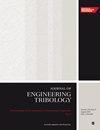考虑柱塞挠度的航空柱塞泵润滑和泄漏特性研究
IF 1.6
3区 工程技术
Q3 ENGINEERING, MECHANICAL
Proceedings of the Institution of Mechanical Engineers, Part J: Journal of Engineering Tribology
Pub Date : 2024-01-22
DOI:10.1177/13506501231225135
引用次数: 0
摘要
针对航空柱塞泵关键摩擦副摩擦严重、磨损大、泄漏大的关键问题,引入压力和剪切流的影响因素修正了间隙流的雷诺治理方程,建立了考虑柱塞挠度的油膜厚度方程,采用有限元法分析了柱塞/缸体副的润滑和泄漏特性,得出以下结论:柱塞的倾角对柱塞对的润滑特性有显著影响,倾斜柱塞的最大油膜压力明显大于非倾斜柱塞,柱塞/缸体对在倾角为 0.00015°.当倾角为 0.00025°时,最大油膜压力约为无倾角时的 14 倍,柱塞偏转时的最小油膜厚度明显小于无倾角时的最小油膜厚度。随着压差的逐渐增大,单个柱塞/缸体对的泄漏率大多呈近似线性上升趋势。当接触长度为 17 mm 时,泄漏量最大,变化曲线的斜率最陡;当单侧间隙增大到 3 µm 以上时,泄漏率明显增大。该研究可为柱塞/缸体对的精确理论设计和航空柱塞泵核心旋转部件的不稳定性提供参考。本文章由计算机程序翻译,如有差异,请以英文原文为准。
Lubrication and leakage characteristic research of aviation plunger pump considering plunger deflection
Aiming at the crucial issues of serious friction, wear and large leakage in the key friction pair on the aviation plunger pump, the influence factors of pressure and shear flow are introduced to correct the Reynolds governing equation of the clearance flow, the oil film thickness equation considering the deflection of the plunger was established, and the lubrication and leakage characteristics of the plunger/cylinder pair are analyzed using finite element method, and the following conclusions are obtained: the inclination angle of the plunger has a significant influence on the lubrication characteristics of the plunger pair, the maximum oil film pressure of the tilted plunger is significantly greater than that of the non-tilted plunger, a transition from elastohydrodynamic lubrication to mixed lubrication occurs in the plunger/cylinder pair at an inclination angle of 0.00015°. When the inclination angle is 0.00025°, the maximum oil film pressure is about 14 times than that without inclination, and the minimum oil film thickness when the plunger is deflected is significantly smaller than that without inclination. As the pressure difference gradually increases, the leakage ratio of a single plunger/cylinder pair mostly shows an approximate linear increase trend. When the contact length is 17 mm, the leakage amount is the largest and the slope of the varied curve is the steepest, when the unilateral clearance increases above 3 µm, the leakage ratio increases significantly. The research can provide references for the plunger/cylinder pair precise theoretical design and the instability of the core rotating components of aviation plunger pumps.
求助全文
通过发布文献求助,成功后即可免费获取论文全文。
去求助
来源期刊

CiteScore
4.20
自引率
5.00%
发文量
110
审稿时长
6.1 months
期刊介绍:
The Journal of Engineering Tribology publishes high-quality, peer-reviewed papers from academia and industry worldwide on the engineering science associated with tribology and its applications.
"I am proud to say that I have been part of the tribology research community for almost 20 years. That community has always seemed to me to be highly active, progressive, and closely knit. The conferences are well attended and are characterised by a warmth and friendliness that transcends national boundaries. I see Part J as being an important part of that community, giving us an outlet to publish and promote our scholarly activities. I very much look forward to my term of office as editor of your Journal. I hope you will continue to submit papers, help out with reviewing, and most importantly to read and talk about the work you will find there." Professor Rob Dwyer-Joyce, Sheffield University, UK
This journal is a member of the Committee on Publication Ethics (COPE).
 求助内容:
求助内容: 应助结果提醒方式:
应助结果提醒方式:


